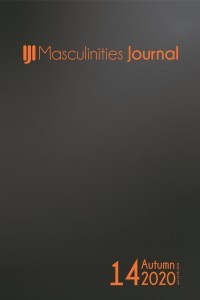An Analysis of Trans Men’s Conceptions and Navigation of Masculinity
An Analysis of Trans Men’s Conceptions and Navigation of Masculinity
The trans body in transition is a complex negotiation, a continual self-examination consisting of building and rebuilding of the self in relation to the transitioning body and to the social, cultural and linguistic structures of gender norms and binary differences. Ways in which trans men embody masculinity while renegotiating their transitioning bodies cannot be fully understood without considering the sociocultural parameters that define cisgender (not transgender) male characteristics, bodies, and masculinities which trans men knowingly or unknowingly may aspire to embody. Physiology or physical differences may become a salient factor in the perception, embodiment or selection of a normative masculinity. There may also be a sense of loss and a mismatch between the performative masculinity and the emergent masculinity, shifting as trans men relate to and/or choose to subvert the conceptions of the dominant societal characteristics of masculinity. This paper aims to gain insight on the specific social and affective factors that impact trans men’s definitions, performance and navigation of their own masculinity. The author will share findings from a qualitative study conducted using semi-structured interviews with trans men of different age groups. The research is driven by the following questions: What meaning do trans men ascribe to normative constructs of masculinity while constructing their body and in what ways does this meaning attach to and apply a given masculinity to the trans male body? What salient linguistic practices do trans men orient themselves towards to exercise or exert their own conceptions of masculinity? In what ways trans men’s self-identification and assertion of their masculinities dependent or independent of relational and social meanings, characteristics and perspectives ascribed to masculinity?
Keywords:
Trans men, performativity, masculinity, gender identities embodiment,
___
- Ahmed, S. (2014). The Cultural Politics of Emotion. Edinburgh University Press.
- Barutçu, A. (2013). Türkiye’de Erkeklik İnşasının Bedensel ve Toplumsal Aşamaları [Physical and Social Phases of Construction of Masculinity in Turkey]. (Master’s thesis). Retrieved from https://www.academia.edu/15073163/T%C3%BCrkiyede_Erkeklik_%C4%B0n%C5%9Fas%C4%B1n%C4%B1n_Bedensel_ve_Toplumsal_A%C5%9Famalar%C4%B1
- Boratav, H. B., Fişek, G. O., & Ziya, H. E. (2017). Erkekliğin Türkiye Halleri [Manhood in Turkey]. Istanbul: Bilgi Üniversitesi.
- Butler, J. (2009). Performativity, Precarity and Sexual Politics. AIBR. Revista de Antropología Iberoamericana 4(3). doi:10.11156/aibr.040305.
- Connell, R. W. (2015). Masculinities: The Field of Knowledge. 58. 39-51. In Horlacher, S. (Eds.), Configuring Masculinity in Theory and Literary Practice. Leiden, The Netherlands: Brill | Rodopi. doi: https://doi.org/10.1163/9789004299009
- Connell, R. W., & Messerschmidt, J.W. (2005). Hegemonic Masculinity Rethinking the Concept. Gender & Society, 19(6), (829-859).
- Devor, A. H. (1989). Gender blending: Confronting the limits of duality. Bloomington: Indiana University Press.
- Ekins, R., & King, D. (2005). Transgendering, Men, and Masculinities. In Kimmel, M. S., Hearn, J., & Connell, R. W. (Eds), Handbook of Studies on Men & Masculinities (pp. 379-394). Thousand Oaks, Calif.: Sage Publications.
- Gerschick, J. T. (2005). Masculinity and Degrees of Bodily Normativity in Western Culture. In Kimmel, M. S., Hearn, J., & Connell, R. W. (Eds), Handbook of Studies on Men & Masculinities (pp. 367-375). Thousand Oaks, Calif.: Sage Publications.
- Holliday, R. (1999). The Comfort of Identity. Sexualities 2(4), 475-491.
- Massumi, B. (2002). Parables for the Virtual: Movement, Affect, Sensation. Durham, NC: Duke University Press.
- Prosser, J. (1998). A Skin of One’s Own: Toward a Theory of Transsexual Embodiment. In Prosser, J., Second Skins: The Body Narratives of Transsexuality (pp. 99-134). Retrieved from http://ebookcentral.proquest.com
- Ratele, K. (2013). Masculinities without Tradition, Politikon. South African Journal of Political Studies, 40:1, 133-156.
- Roen, K. (2001). Of Right Bodies and Wrong Bodies: The Forging of Corpus Transsexualis Through Discursive Manoeuvre and Surgical Manipulation. International Journal of Critical Psychology, 3, 98-121.
- Sancar, S. (2016). Erkeklik: İmkȃnsız İktidar–Ailede, Piyasada ve Sokakta Erkekler [Masculinity: Impossible Power–Men in the Family, on the Market and on the Street]. Istanbul: Metis.
- Stryker, S. (2006). (De)Subjugated Knowledges: An Intoduction to Transgender Studies. In Stryker, S., & Whittle, S. (Eds.), The Transgender Studies Reader (pp.1-17). New York: Routledge.
- Şenol, D., & Erdem, S. (2017). The Role of the Social Process on Hegemonic Manhood in Turkish Society. TURAN-SAM International Journal for Scientific Seasonal Writing Refereed, 9(33), 290-299.
- Vegter, V. (2013). Conceptualizing Masculinity in Female-to-Male Trans-Identified Individuals: A Qualitative Inquiry. Canadian Journal of Counseling and Psychotherapy, 47(1), 88-108.
- Vidal-Ortiz, S. (2005). Queering Sexuality and Doing Gender: Transgender Men's Identification with Gender and Sexuality. Advances in Gender Research, 6, 181-233.
- West, C., & Zimmerman, H. D. (1989). Doing Gender. Gender & Society, 1(2),125-151.
- White, D. (2017). Affect: An Introduction. Cultural Anthropology 32(2), 175-180.
- Whittle, S. (2006). Where did we go Wrong: Feminism and Trans Theory–Two Teams on the Same Side. In Stryker, S., & Whittle, S. (Eds.), The Transgender Studies Reader (pp.194-202). New York: Routledge.
- Zimman, L. (2015). Trans Masculinity and the Voice: Gender Assignment, Identity and Presentation. In Milani, M. T. (Ed.), Language and Masculinities: Performances, Intersections, Dislocations (pp. 197-219). Routledge.
- Başlangıç: 2014
- Yayıncı: Eleştirel Erkeklik İncelemeleri İnisiyatifi
